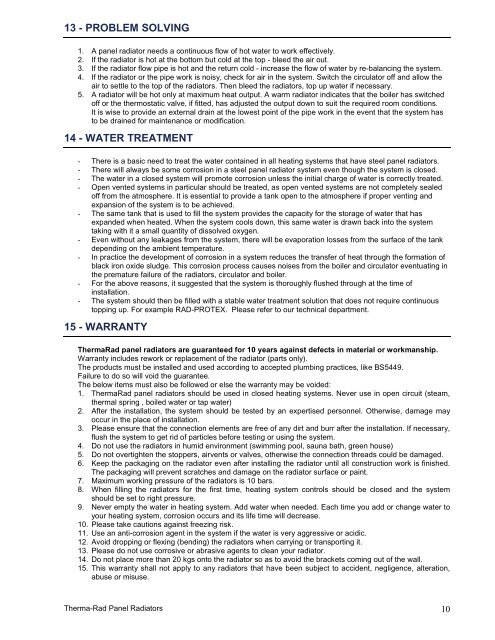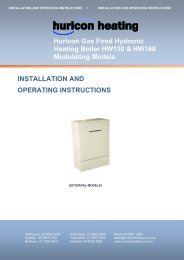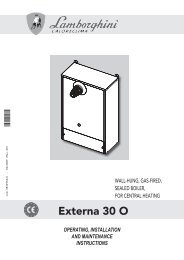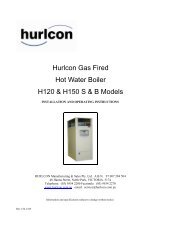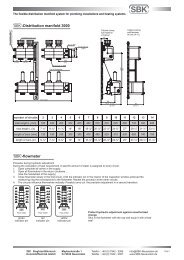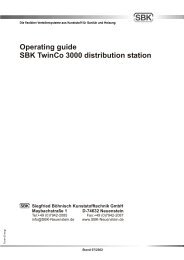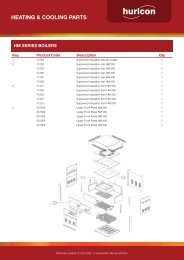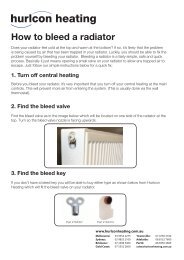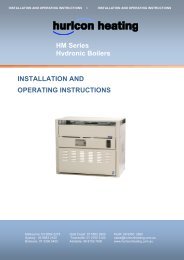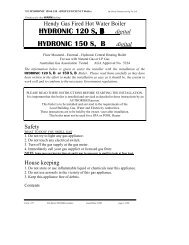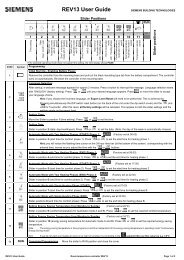Therma - Rad Draft.pdf - Hurlcon Heating
Therma - Rad Draft.pdf - Hurlcon Heating
Therma - Rad Draft.pdf - Hurlcon Heating
You also want an ePaper? Increase the reach of your titles
YUMPU automatically turns print PDFs into web optimized ePapers that Google loves.
13 - PROBLEM SOLVING<br />
1. A panel radiator needs a continuous flow of hot water to work effectively.<br />
2. If the radiator is hot at the bottom but cold at the top - bleed the air out.<br />
3. If the radiator flow pipe is hot and the return cold - increase the flow of water by re-balancing the system.<br />
4. If the radiator or the pipe work is noisy, check for air in the system. Switch the circulator off and allow the<br />
air to settle to the top of the radiators. Then bleed the radiators, top up water if necessary.<br />
5. A radiator will be hot only at maximum heat output. A warm radiator indicates that the boiler has switched<br />
off or the thermostatic valve, if fitted, has adjusted the output down to suit the required room conditions.<br />
It is wise to provide an external drain at the lowest point of the pipe work in the event that the system has<br />
to be drained for maintenance or modification.<br />
14 - WATER TREATMENT<br />
- There is a basic need to treat the water contained in all heating systems that have steel panel radiators.<br />
- There will always be some corrosion in a steel panel radiator system even though the system is closed.<br />
- The water in a closed system will promote corrosion unless the initial charge of water is correctly treated.<br />
- Open vented systems in particular should be treated, as open vented systems are not completely sealed<br />
off from the atmosphere. It is essential to provide a tank open to the atmosphere if proper venting and<br />
expansion of the system is to be achieved.<br />
- The same tank that is used to fill the system provides the capacity for the storage of water that has<br />
expanded when heated. When the system cools down, this same water is drawn back into the system<br />
taking with it a small quantity of dissolved oxygen.<br />
- Even without any leakages from the system, there will be evaporation losses from the surface of the tank<br />
depending on the ambient temperature.<br />
- In practice the development of corrosion in a system reduces the transfer of heat through the formation of<br />
black iron oxide sludge. This corrosion process causes noises from the boiler and circulator eventuating in<br />
the premature failure of the radiators, circulator and boiler.<br />
- For the above reasons, it suggested that the system is thoroughly flushed through at the time of<br />
installation.<br />
- The system should then be filled with a stable water treatment solution that does not require continuous<br />
topping up. For example RAD-PROTEX. Please refer to our technical department.<br />
15 - WARRANTY<br />
<strong>Therma</strong><strong>Rad</strong> panel radiators are guaranteed for 10 years against defects in material or workmanship.<br />
Warranty includes rework or replacement of the radiator (parts only).<br />
The products must be installed and used according to accepted plumbing practices, like BS5449.<br />
Failure to do so will void the guarantee.<br />
The below items must also be followed or else the warranty may be voided:<br />
1. <strong>Therma</strong><strong>Rad</strong> panel radiators should be used in closed heating systems. Never use in open circuit (steam,<br />
thermal spring , boiled water or tap water)<br />
2. After the installation, the system should be tested by an expertised personnel. Otherwise, damage may<br />
occur in the place of installation.<br />
3. Please ensure that the connection elements are free of any dirt and burr after the installation. If necessary,<br />
flush the system to get rid of particles before testing or using the system.<br />
4. Do not use the radiators in humid environment (swimming pool, sauna bath, green house)<br />
5. Do not overtighten the stoppers, airvents or valves, otherwise the connection threads could be damaged.<br />
6. Keep the packaging on the radiator even after installing the radiator until all construction work is finished.<br />
The packaging will prevent scratches and damage on the radiator surface or paint.<br />
7. Maximum working pressure of the radiators is 10 bars.<br />
8. When filling the radiators for the first time, heating system controls should be closed and the system<br />
should be set to right pressure.<br />
9. Never empty the water in heating system. Add water when needed. Each time you add or change water to<br />
your heating system, corrosion occurs and its life time will decrease.<br />
10. Please take cautions against freezing risk.<br />
11. Use an anti-corrosion agent in the system if the water is very aggressive or acidic.<br />
12. Avoid dropping or flexing (bending) the radiators when carrying or transporting it.<br />
13. Please do not use corrosive or abrasive agents to clean your radiator.<br />
14. Do not place more than 20 kgs onto the radiator so as to avoid the brackets coming out of the wall.<br />
15. This warranty shall not apply to any radiators that have been subject to accident, negligence, alteration,<br />
abuse or misuse.<br />
<strong>Therma</strong>-<strong>Rad</strong> Panel <strong>Rad</strong>iators 10


